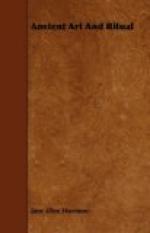The death and resurrection of the gods, and pari passu of the life and fruits of the earth, was thus set forth in ritual, but—and this is our immediate point—it was also set forth in definite, unmistakable art. In the great temple of Isis at Philae there is a chamber dedicated to Osiris. Here is represented the dead Osiris. Out of his body spring ears of corn, and a priest waters the growing stalk from a pitcher. The inscription to the picture reads: This is the form of him whom one may not name, Osiris of the mysteries, who springs from the returning waters. It is but another presentation of the ritual of the month Choiak, in which effigies of the god made of earth and corn were buried. When these effigies were taken up it would be found that the corn had sprouted actually from the body of the god, and this sprouting of the grain would, as Dr. Frazer says, be “hailed as an omen, or rather as the cause of the growth of the crops."[1]
Even more vividly is the resurrection set forth in the bas-reliefs that accompany the great Osiris inscription at Denderah. Here the god is represented at first as a mummy swathed and lying flat on his bier. Bit by bit he is seen raising himself up in a series of gymnastically impossible positions, till at last he rises from a bowl—perhaps his “garden”—all but erect, between the outspread wings of Isis, while before him a male figure holds the crux ansata, the “cross with a handle,” the Egyptian symbol of life. In ritual, the thing desired, i.e. the resurrection, is acted, in art it is represented.
No one will refuse to these bas-reliefs the title of art. In Egypt, then, we have clearly an instance—only one out of many—where art and ritual go hand in hand. Countless bas-reliefs that decorate Egyptian tombs and temples are but ritual practices translated into stone. This, as we shall later see, is an important step in our argument. Ancient art and ritual are not only closely connected, not only do they mutually explain and illustrate each other, but, as we shall presently find, they actually arise out of a common human impulse.
* * * * *
The god who died and rose again is not of course confined to Egypt; he is world-wide. When Ezekiel (viii. 14) “came to the gate of the Lord’s house which was toward the north” he beheld there the “women weeping for Tammuz.” This “abomination” the house of Judah had brought with them from Babylon. Tammuz is Dumuzi, “the true son,” or more fully, Dumuzi-absu, “true son of the waters.” He too, like Osiris, is a god of the life that springs from inundation and that dies down in the heat of the summer. In Milton’s procession of false gods,
“Thammuz
came next behind,
Whose annual wound in Lebanon
allured
The Syrian damsels to lament
his fate
In amorous ditties all a summer’s
day.”
Tammuz in Babylon was the young love of Ishtar. Each year he died and passed below the earth to the place of dust and death, “the land from which there is no returning, the house of darkness, where dust lies on door and bolt.” And the goddess went after him, and while she was below, life ceased in the earth, no flower blossomed and no child of animal or man was born.




